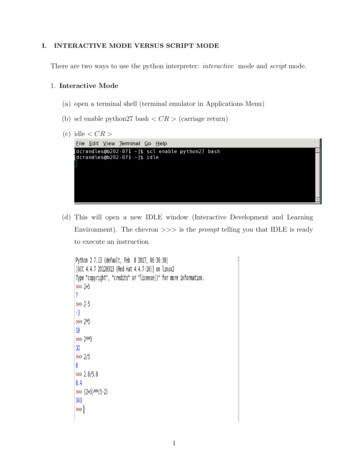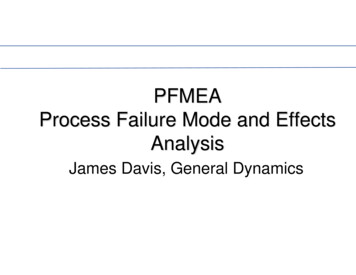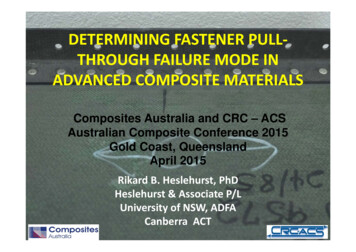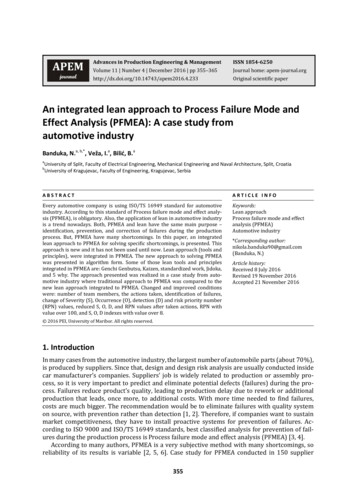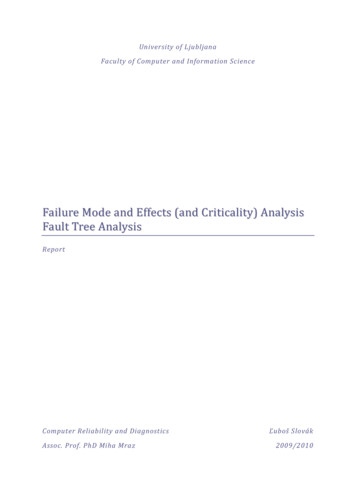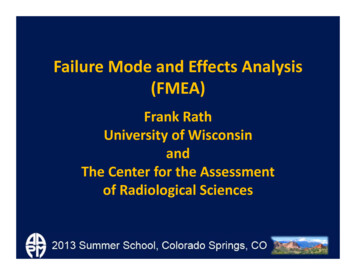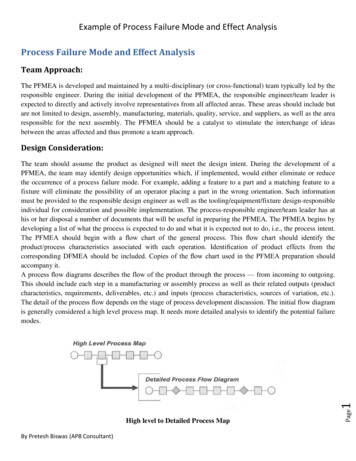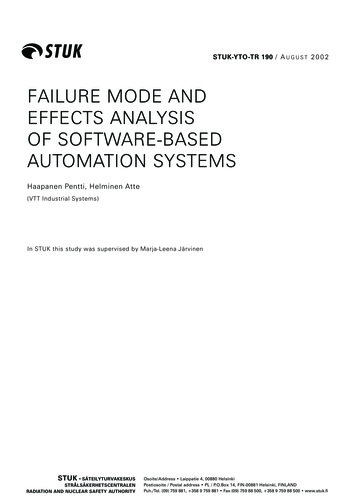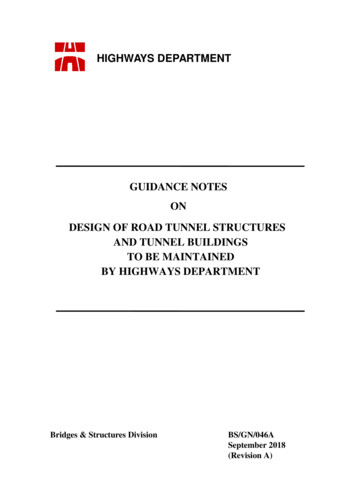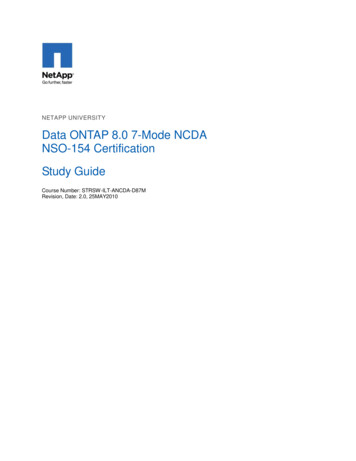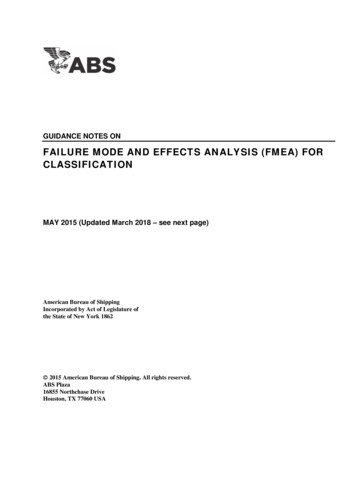
Transcription
Guidance Notes on Failure Mode and Effects Analysis (FMEA) for ClassificationGUIDANCE NOTES ONFAILURE MODE AND EFFECTS ANALYSIS (FMEA) FORCLASSIFICATIONMAY 2015 (Updated March 2018 – see next page)American Bureau of ShippingIncorporated by Act of Legislature ofthe State of New York 1862 2015 American Bureau of Shipping. All rights reserved.ABS Plaza16855 Northchase DriveHouston, TX 77060 USA
UpdatesMarch 2018 consolidation includes: September 2017 version plus Corrigenda/EditorialsSeptember 2017 consolidation includes: July 2015 version plus Corrigenda/EditorialsJuly 2015 consolidation includes: May 2015 version plus Corrigenda/Editorials
ForewordForewordABS requires clients to develop and submit FMEAs as part of Classification requirements for select systems.For instance, FMEAs are required for achieving many of the special or optional Classification notationssuch as CDS, ACC, ACCU, R1, RQ, DPS-2, DPS-3, ISQM. This document provides guidance and insightinto the development process for FMEAs to comply with ABS Classification rule requirements. The utilizationof this guidance will provide tangible benefits as the marine and offshore industry is able to realize thepositive results of FMEAs that are developed correctly and managed appropriately throughout the lifecycleof a system. Some of these benefits include FMEAs that meet the intended objectives and are a support to the classification process Consistency in scope, depth and quality among comparable FMEAs Expedited FMEA review process Reduced failures, downtimes and incidentsThese Guidance Notes become effective on the first day of the month of publication.Users are advised to check periodically on the ABS website www.eagle.org to verify that this version ofthese Guidance Notes is the most current.We welcome your feedback. Comments or suggestions can be sent electronically by email to rsd@eagle.org.Terms of UseThe information presented herein is intended solely to assist the reader in the methodologies and/or techniquesdiscussed. These Guidance Notes do not and cannot replace the analysis and/or advice of a qualifiedprofessional. It is the responsibility of the reader to perform their own assessment and obtain professionaladvice. Information contained herein is considered to be pertinent at the time of publication, but may beinvalidated as a result of subsequent legislations, regulations, standards, methods, and/or more updatedinformation and the reader assumes full responsibility for compliance. This publication may not be copiedor redistributed in part or in whole without prior written consent from ABS.ABS GUIDANCE NOTES ON FAILURE MODE AND EFFECTS ANALYSIS (FMEA) FOR CLASSIFICATION . 2015iii
Table of ContentsGUIDANCE NOTES ONFAILURE MODE AND EFFECTS ANALYSIS (FMEA) FORCLASSIFICATIONCONTENTSSECTION 1Introduction . 11Background .12Purpose of FMEAs .13FMEA Overview .13.1SECTION 2TABLE 1Index of System-Specific Guidance for ABS FMEARequirements .3FIGURE 1Process Flow for Classification Required FMEAs .4Before the FMEA. 51Preparing for the FMEA .5234ivFMEA Process in a Nutshell . 21.1FMEA Standards . 51.2Design Philosophy and FMEAs . 6FMEA Scope and Ground Rules .72.1Equipment Scope and Physical Boundaries . 72.2Operational Boundaries (Global and Local) . 92.3Failure Criteria and Types of Failure. 92.4Depth of Analysis . 92.5Criticality Ranking (FMECA) . 102.6FMEA Naming Convention within this Document . 112.7US Coast Guard Supplemental Requirements for QualitativeFailure Analyses (QFA) . 11FMEA Team .123.1Stakeholder’s Workshop Setting . 123.2Third-Party FMEA Practitioner(s) . 123.3ABS Participation in the FMEA Workshop . 133.4Team Preparation . 13Ideal Timing to Conduct FMEAs .13TABLE 1TABLE 2Typical Corrective Actions to Control Failure Scenarios.6Examples of System/Subsystem’s Physical Boundaries(for a DP System).8FIGURE 1Typical Risk Matrix for FMECA .11ABS GUIDANCE NOTES ON FAILURE MODE AND EFFECTS ANALYSIS (FMEA) FOR CLASSIFICATION . 2015
SECTION 3Developing the FMEA . 151Developing the FMEA . 152Data Management . 153SECTION 4Data Collection to Support the Analysis . 152.2Other Risk Analysis as Input to the FMEA. 152.3Data Analysis . 15FMEA Study . 173.1Define the Analysis . 183.2Develop the Analysis Approach. 183.3Identify Failure Modes . 203.4Analyze Effects. 243.5Identify Failure Detection Methods . 253.6Identify Existing Risk Control Methods . 253.7Criticality Ranking (for FMECA) . 253.8Identify Corrective Actions . 26TABLE 1Risk Analyses that could Provide Input Information to anFMEA . 16TABLE 2TABLE 3Sample FMEA/FMECA Worksheet . 20Sample Failure Modes of Mechanical and ElectricalComponents . 21FIGURE 1FIGURE 2FIGURE 3FMEA Study Flowchart . 17Reliability Block Diagram (or Dependency Diagrams) . 18Example of External/Operational Forces That May ImpactFMEA Study . 19FMEA Report and Classification Review of FMEA . 271FMEA Report . 272SECTION 52.11.1Report Structure . 271.2FMEA Internal Review Process . 29Classification Review of the FMEA . 292.1Pitfalls and Common Problems in Classification SubmittedFMEA . 292.2FMEA and Supporting Documentation Submittal . 30TABLE 1Sample FMEA Report Structure . 28FIGURE 1Sample Cause and Effect Matrix . 31FMEA Verification Program . 321Purpose . 321.1Scope of FMEA Verification Program . 321.2Verification Program Test Sheets . 331.3Performing FMEA Verification Program . 341.4Results and Recommendations . 341.5FMEA Verification Program Report . 351.6United States Coast Guard Design Verification Test Procedure . 36ABS GUIDANCE NOTES ON FAILURE MODE AND EFFECTS ANALYSIS (FMEA) FOR CLASSIFICATION . 2015v
SECTION 6SECTION 7viTABLE 1Sample FMEA Verification Program Report Structure(for a DP FMEA).35FIGURE 1FMEA Trial Test Sheet Example.34FMEA Lifecycle Management . 371Best Practices for FMEA as a Living Document .371.1Best Practices for FMEA as an Operations ResourceDocument . 371.2Best Practices for FMEA Lifecycle Management . 381.3Changes to the Classed System and FMEA Revisions andSubmittals . 381.4FMEA and Management of Change . 38TABLE 1Suggested Entries in Management of Change Form forFMEAs .39FIGURE 1FMEA Lifecycle Management .39System-Specific FMEA Requirements . 401Guidance for System-Specific FMEA Requirements .401.1Automation (General Control, Safety-Related Functions ofComputer-Based Systems, Wireless Data Communication,Integrated Automation Systems). 441.2Electronically Controlled Diesel Engines . 501.3Remote Control Propulsion [Automatic Centralized Control(ACC), Automatic Centralized Control Unmanned (ACCU),Automatic Bridge Centralized Control Unmanned (ABCU)] . 541.4Gas Turbine . 581.5Redundant Propulsion and Steering . 621.6Single Pod Propulsion . 661.7Dynamic Positioning Systems (DPS) . 691.8Software Control System . 781.9Jacking Systems . 861.10Subsea Heavy Lifting . 901.11Drilling Systems/Subsystems/Individual Equipment . 931.12Integrated Drilling Plant . 1001.13Dual Fuel Diesel Engines (DFDE) . 1081.14Gas-Fueled Engines . 1131.15Motion Compensation and Rope Tensioning Systems forCranes . 119TABLE 1Index of FMEA Requirements in ABS Rules and Guides .41TABLE 2Structure of the Guidance for Each FMEA Requirement .42TABLE 3Sample DP FMEA Worksheet Template.77ABS GUIDANCE NOTES ON FAILURE MODE AND EFFECTS ANALYSIS (FMEA) FOR CLASSIFICATION . 2015
APPENDIX 1 Definitions, Acronyms and Abbreviations . 1221Definitions . 1222Acronyms and Abbreviations . 125APPENDIX 2 Sample FMEA/FMECA Worksheets . 1261Sample FMEA/FMECA Worksheets . 1261.1FMECA Worksheet Example (for ISQM and for CDS) . 126TABLE 1Example of BOP Control Functional Items . 127TABLE 2FMECA Worksheet Example (Select Sections of aFMECA for BOP Control System) . 128ABS GUIDANCE NOTES ON FAILURE MODE AND EFFECTS ANALYSIS (FMEA) FOR CLASSIFICATION . 2015vii
This Page Intentionally Left Blank
Section 1: IntroductionSECTION11IntroductionBackgroundIn the marine and offshore industry, design and equipment configurations vary from one system to thenext, and systems are in many cases increasingly complex. There are gaps in codes and standards whichmay lag technological innovations and there are issues related to interfaces between systems. Risk analysessuch as Failure Modes and Effects Analysis (FMEAs) provide a formalized approach to identify hazardoussituations, address the gaps and interc
Foreword. Foreword . ABS requires clients to develop and submit FMEAs as part of Classification requirements for select systems. For instance, FMEAs are required for achieving many of the special or optional Classification notationsFile Size: 2MBPage Count: 137
